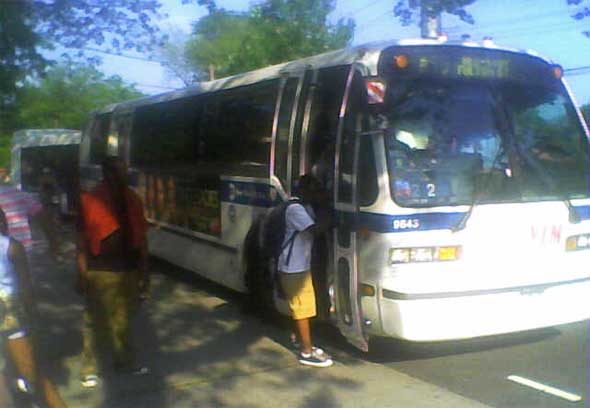MTA Screws Up Memorial Day Bus Service

THE COMMUTE: I have better things to do on Memorial Day than watching buses. But after last year’s mayhem, I thought it was my duty to at least check out the crowding this Memorial Day, especially after the Manhattan Beach Neighborhood Association’s (MBNA) request for additional beach shuttle buses, which I do not believe is necessary. There was no mayhem this year, but things did not go smoothly either.
I arrived at 5:30 p.m. There were 45 people waiting at the Hastings Street stop and another 25 at Falmouth Street. The schedule called for a B1 bus every nine minutes and a B49 every 15 minutes. B1 buses were leaving with seated loads or a few standees, which seemed adequate. However, that was not the case with the B49. A B49 bus passes both stops not in service on its way to the depot. About five minutes later, a B49 picks up passengers from both stops and leaves full with about 75 passengers on board. That is the bus pictured above. About 12 people are left, forced to wait another 15 minutes for the next B49. They were not going to the subway because they chose to let the B1 (pictured behind) pass by, which had room, disproving the MBNA’s assertion that everyone just wants to go to the subway. There also was no room on the B49 for any more passengers getting on after Falmouth Street, so waiting passengers between Dover Street and the Brighton subway had to wait half an hour or more for a bus.
When buses are too crowded for everyone to board, it is foolhardy to send empty buses back to the depot when those buses could at least take some passengers to the subway. But even more could be done. B49 bus schedules could be rewritten so that no buses go out of service at the time when people are leaving the beach. In fact, it had already been done 30 years ago.
When I was Director of Planning in 1981, the bus schedules called for every other B49 bus to go out of service at Avenue U. Those buses were leaving the beach almost empty, while the buses traveling the entire route were bursting at the seams. I asked Schedules to see if they could send the Avenue U buses to Farragut Road instead, and run off the buses to the depot from there so that buses making their final trip would operate along half the route before going to the depot and would be usable for a majority of the passengers, in effect doubling the existing service. They rewrote the Schedule and the result was eleven extra trips at a lower operating cost. Buses leaving the beach were no longer overcrowded.
Apparently, the MTA has now returned to their old ways, except now buses running off to the depot do not even take passengers to the subway or to Avenue U. Now they operate “Not in Service.” I did not wait around to actually count the number of buses operating “Not in Service,” but most likely it was more than one. If it was more efficient to operate buses running off to the depot to Farragut Road (Foster Avenue today) 30 years ago, I see no reason why it would not be more efficient today.
At certain times it makes sense to send buses not in service to and from the depot. It clearly makes no sense when buses are so crowded that they are forced to bypass stops forcing extra-long waits. It is a deterrent to riding the buses. Yet the MTA cannot figure out why bus ridership is declining. More on that tomorrow.
The Commute is a weekly feature highlighting news and information about the city’s mass transit system and transportation infrastructure. It is written by Allan Rosen, a Manhattan Beach resident and former Director of MTA/NYC Transit Bus Planning (1981).




